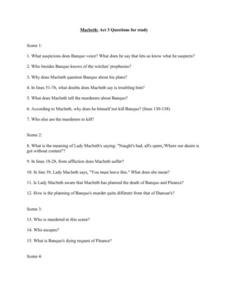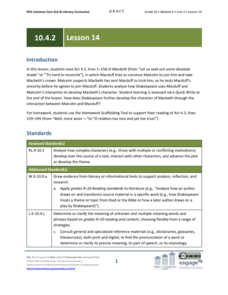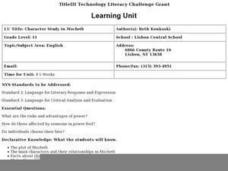Curated OER
Shakespeare, Macbeth: Characterization and Theme
In this literary elements worksheet, students read Shakespeare's Macbeth and then respond to 13 short answer questions about the characters and themes in the play.
Curated OER
Can You Hear Macbeth Now?
Students explore how sound affects scene understanding using the Shakespeare play Macbeth. In this audio and play analysis instructional activity, students respond to Macbeth events as if they were at a sporting event. Students listen to...
Curated OER
Macbeth: What's Up with the Crime Scene?
High schoolers are introduced to Macbeth by having them act out the scene where Duncan's murder is discovered. This activity enable students to use dialogue only to discover the structure and format of a scene and explain plot.
Lesson Locker
Macbeth: Act Three Questions for Study
The 29 specified questions included in this resource cover the climax in Act three of Shakespeare’s Macbeth. Test your students by using this activity as a reading check quiz, group work exercise, or to illicit class discussion. If given...
EngageNY
Grade 10 ELA Module 4: Unit 3, Lesson 5
Would Machiavelli consider Macbeth a successful ruler? Scholars ponder the intriguing question, demonstrating their knowledge of Shakespeare's Macbeth and Machiavelli's The Prince. They collaborate with peers to share their opinions,...
EngageNY
Grade 10 ELA Module 4, Unit 2, Lesson 20
Using the resource, scholars work in small groups to rehearse a selected scene from Shakespeare's Macbeth. Finally, they present their interpretive dramatic readings to a group of peers or the whole class and complete a self-assessment...
EngageNY
Grade 10 ELA Module 4: Unit 2, Lesson 13
Lady Macduff uses a metaphor to suggest that her husband does not possess the courage of even a tiny, short-winged bird—ouch! Using the resource, pupils discover Act 4.2 of Shakespeare's Macbeth. Using reading, writing, and discussion,...
Lesson Locker
Macbeth: Act Two Questions for Study
There are 21 considerable examinations of the rising action of Act 2 of Shakespeare’s Macbeth. Use this resource for a productive group-work activity, a quiz, or to spark conversation about the play. Note: If given for homework, the...
Lesson Locker
Macbeth: Act Four Questions for Study
Readers of Macbeth can use these study questions to keep track of key events in Act IV of Shakespeare’s tragedy. Consider adding interpretative and evaluative questions to encourage analysis and critical thinking skills.
Curated OER
Acting in Marriage-Is It on Stage or Off?
Learners compare views of marriage in Macbeth and Cat on a Hot Tin Roof. In this comparative literature instructional activity, students discuss and debate the marriages of Macbeth and Lady Macbeth in Shakespeare's Macbeth Brick and...
Curated OER
Do the Research! Macbeth Becomes King of Scotland
In this research worksheet, students find information about Macbeth the King of Scotland. Students answer 4 essay and short answer questions about Macbeth.
EngageNY
Grade 10 ELA Module 4: Unit 2, Lesson 14
How does Shakespeare further develop Macbeth's character using the interaction between Macduff and Malcolm? Pupils write responses to the question. They continue their analysis of Macbeth with a masterful reading and guided whole-class...
EngageNY
Grade 10 ELA Module 4: Unit 2, Lesson 12
How do the Three Witches' interactions with Macbeth advance the plot of Shakespeare's Macbeth? Learners complete a Quick Write to answer the question. They also participate in a whole-class dramatic reading of Act 4.1.
Curated OER
The Learning Network Fill-In: Macbeth for Children
Help your learners attain vocabulary and practice reading comprehension with this cloze activity. Created by The Learning Network, this resource provides a New York Times article with the words already removed. Pupils can fill in the...
Curated OER
Character Study in Macbeth
Eleventh graders analyze a Shakespeare soliloquy by writing a prose summary of it. They keep a character journal, following one character through the play and analyzing what the character does and says, as well as, might have done or...
Curated OER
Double, Double, Toil and Trouble: A Dual Exploration of Macbeth
High schoolers emulate a key practice of Renaissance theater: doubling. The goal of this lesson is for students to experience-to see, hear, and feel-the differences between characters. Each group presents scenes to the rest of the class.
ReadMagazine
William Shakespeare
Is this an interactive resource I see before me? Fret not. Here's a resource filled with sound, and a bit of fury, sure to engage learners in a study of Shakespeare's Scottish play. User can view an interview with Shakespeare, examine...
Curated OER
Shakespeare Quiz 3
In this Shakespeare Quiz 3 activity, students answer 20 trivia-style questions about Shakespearean plays, then scroll down to check their answers.
Curated OER
Shakespeare Quiz 1
In this Shakespeare worksheet, learners identify the characters in the novels written by the famous author. Students complete 20 short answer questions.
Curated OER
Hamlet Research Paper: Find, Evaluate, and Select Appropriate Research Sources
Help young researchers find credible sources online. Modeling with a Google search for information about Shakespeare’s Macbeth, use a computer projector or Smart Board to show class members how weak the top three search results are....
Curated OER
Tears of Tiger Pages 106-122
In these Tears of Tiger worksheets, students complete several short answer questions in order to advance their understanding of the text.
Curated OER
Making a Board Game: Macbeth B2
Young scholars are given a rubic for their project on Making a Board Game. They can see how the points are broken down and what they have to do in order to recieve a great grade. Students are given 6 different categories that they can...
Curated OER
Julius Caesar: iambic pentameter
Read in iambic pentameter! Read Julius Caesar and Macbeth to study the famous meter. While the lesson points out the specific passages to use, you'll have to find them and copy them yourself.
Curated OER
And. . . Freeze!
Learners read a short section of a scene very closely and develop a tableaux as a start to the performance process. They write a paragraph in the voice of a character. They present their beginning, middle and end tableaux to the class.

























